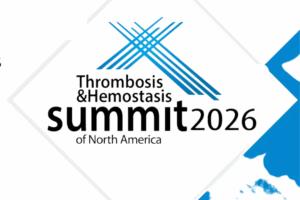MASAB Medical Memo #2, September 2017
Should we keep the pressure on? Graduated compression stockings for prevention of post-thrombotic syndrome.
by Michael B. Streiff M.D., Associate professor of Medicine and Pathology, Johns Hopkins School of Medicine, Baltimore
 Post-thrombotic syndrome (PTS) is a common complication following a blood clot. Up to 30 to 50 percent of patients who have a deep vein thrombosis (DVT) can develop symptoms of PTS. These can include leg swelling, pain, heaviness, varicose veins, skin discoloration and skin breakdown.1 Five to ten percent of patients experience severe signs of PTS, such as skin ulcers that develop on the legs. These can require long term wound care and/or surgery to treat. It has been estimated that PTS results in at least $200 million in medical costs each year.2
Post-thrombotic syndrome (PTS) is a common complication following a blood clot. Up to 30 to 50 percent of patients who have a deep vein thrombosis (DVT) can develop symptoms of PTS. These can include leg swelling, pain, heaviness, varicose veins, skin discoloration and skin breakdown.1 Five to ten percent of patients experience severe signs of PTS, such as skin ulcers that develop on the legs. These can require long term wound care and/or surgery to treat. It has been estimated that PTS results in at least $200 million in medical costs each year.2
Until very recently, most physicians considered it essential to prescribe graduated compression stockings (GCS) to all patients with DVT to help prevent PTS. The wisdom of this practice was justified by two research studies published in 1997 and 2004.3, 4
However, a study published in 2014 casts doubt on this practice. The SOX trial was a randomized, controlled study to determine if GCS were effective for prevention of PTS.5 Patients who had a DVT were given either GCS or placebo stockings. The cumulative rate of PTS at 6 months or later was 14.2 percent the GCS group and 12.7 percent the placebo stocking group. In addition, there was no difference in leg ulcers or repeated blood clots between the groups. The authors concluded that GCS do not prevent PTS after a first episode of a blood clot 5 and also noted that GCS did not reduce leg pain after a DVT.6
What do these results mean for patients? The best available information indicates that GCS do not prevent PTS.5 Therefore, most physicians no longer recommend that patients with DVT wear GCS to prevent PTS. If GCS is not the answer, is there anything else healthcare providers and patients can do to reduce the chances of PTS after a clot? Being overweight, not taking medication as prescribed, and recurrent DVT place patients at higher risk for PTS.1 Therefore, patients and providers should focus on avoiding these risk factors to reduce the risk of PTS.
A recent secondary look at studies comparing rivaroxaban (a newer oral blood thinner) to warfarin for the treatment of blood clots suggested that rivaroxaban was associated with a trend (not significant) toward a lower risk of PTS, perhaps due to more consistent anticoagulation with rivaroxaban.7 Larger studies are needed to confirm that direct oral anticoagulants reduce the incidence of PTS. It is also possible that early clot removal using catheter-directed thrombolysis may reduce the risk of PTS. The CAVENT study found that the risk of PTS at five years was reduced by 28 percent in patients who got catheter-directed thrombolysis in addition to blood thinners8. The recently completed ATTRACT trial of catheter-directed thrombolysis should provide more information about the potential benefits of thrombolysis for prevention of PTS.
Until these data are available, providers and patients need not keep the pressure on their legs with stockings, but instead should keep the pressure on reducing their risk of PTS by taking their blood thinner as prescribed by their physician and maintaining a healthy weight.
References
- Rabinovich A, Kahn SR. The postthrombotic syndrome: current evidence and future challenges. J Thromb Haemost 2017;15:230-41.
- Ashrani AA, Heit JA. Incidence and cost burden of post-thrombotic syndrome. J Thromb Thrombolysis 2009;28:465-76.
- Brandjes DP, Buller HR, Heijboer H, et al. Randomised trial of effect of compression stockings in patients with symptomatic proximal-vein thrombosis. Lancet 1997;349:759-62.
- Prandoni P, Lensing AW, Prins MH, et al. Below-knee elastic compression stockings to prevent the post-thrombotic syndrome: a randomized, controlled trial. Ann Intern Med 2004;141:249-56.
- Kahn SR, Shapiro S, Wells PS, et al. Compression stockings to prevent post-thrombotic syndrome: a randomised placebo-controlled trial. Lancet 2014;383:880-8.
- Kahn SR, Shapiro S, Ducruet T, et al. Graduated compression stockings to treat acute leg pain associated with proximal DVT. A randomised controlled trial. Thromb Haemost 2014;112:1137-41.
- Cheung YW, Middeldorp S, Prins MH, et al. Post-thrombotic syndrome in patients treated with rivaroxaban or enoxaparin/vitamin K antagonists for acute deep-vein thrombosis. A post-hoc analysis. Thromb Haemost 2016;116:733-8.
- Haig Y, Enden T, Grotta O, et al. Post-thrombotic syndrome after catheter-directed thrombolysis for deep vein thrombosis (CaVenT): 5-year follow-up results of an open-label, randomised controlled trial. Lancet Haematol 2016;3:e64-71.







